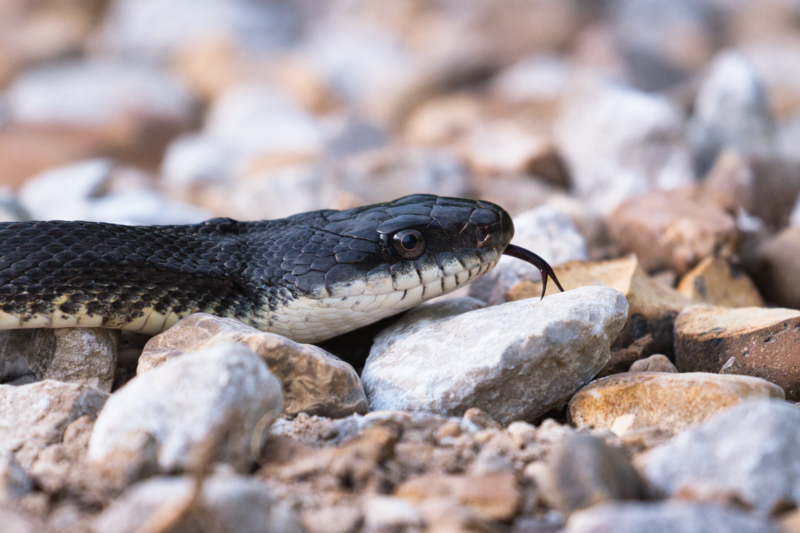I was driving the auto tour road at the Sequoyah National Wildlife Refuge in Oklahoma yesterday when I spotted a Ratsnake in the gravel road between Reeve’s Boat Ramp and the Sandtown turnoff. As a wildlife photographer, I’m always on the lookout for interesting creatures to photograph, so I quickly pulled over and exited my pickup truck. I sat down right there in the road to get eye level with the snake and readied my camera.

The snake was slowly moving along, flicking its tongue out repeatedly onto the rocks ahead of it. I’ve learned that snakes flick their tongues to collect chemical samples from the air or ground to help them smell. Their forked tongues collect odor molecules and deliver them to special sensory cells in the mouth called Jacobson’s organs. This gives snakes a sense of smell and taste that is extremely sensitive, helping them track prey or mates.
I timed my shot perfectly to capture the snake mid-flick with its tongue extended. Getting low to the ground allowed me to zoom in close on the snake while still keeping the gravel road in the background. I’m thrilled with how the image captures a behavior I’ve seen snakes exhibit many times. Expect more close-up snake shots in the future as I continue observing and photographing these fascinating reptiles in their natural habitats. Capturing snake behaviors and reptile biodiversity in images is my passion as a wildlife photographer.
Can a rat snake hurt you?
Ratsnakes are non-venomous constrictors that are found throughout much of the Northern Hemisphere. They are medium to large and feed primarily on rodents. While they can be defensive when approached too closely, handled, or restrained, ratsnake bites are not dangerous to humans. Although the bite of a rat snake isn’t fatal, it can be rather painful and full of bacteria that can infect you. Rat snakes are gentle creatures and are unlikely to attack humans upon contact. They are also beneficial to humans, especially farmers, in controlling rodent populations.
Gear Used:
- Camera: Fujifilm X-T3
- Lens: Canon EF 100-400 mm f/4.5-5.6 L IS II USM (attached with a Fringer EF-FX Pro)
Technical:
- Location: Sequoyah National Wildlife Refuge (Oklahoma)
- Date and Time Taken: July 22, 2021 (8:43 A.M.)
- Program Mode: Aperture Priority
- Aperture: f5.6
- Shutter speed: 1/2400 (as determined by the camera)
- ISO: 800
- Focal Length: 400 mm
